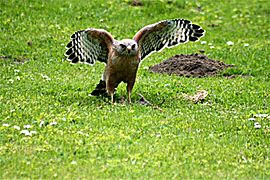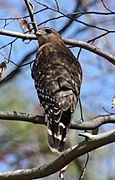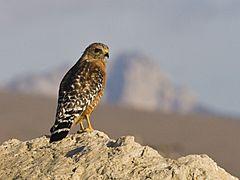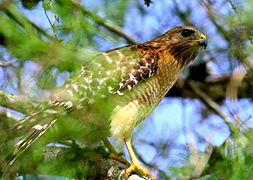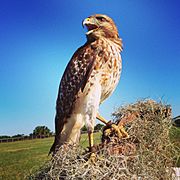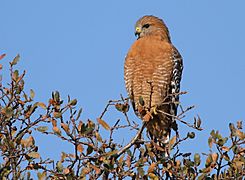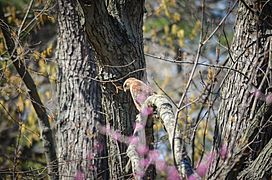Red-shouldered hawk facts for kids
Quick facts for kids Red-shouldered hawk |
|
|---|---|
 |
|
| Red-shouldered hawk near Blue Cypress Lake, Florida. | |
| Conservation status | |
| Scientific classification | |
| Genus: |
Buteo
|
| Species: |
lineatus
|
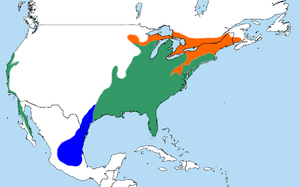 |
|
| Range of B. lineatus Breeding range Year-round range Wintering range | |
The red-shouldered hawk (Buteo lineatus) is a medium-sized hawk. It lives in eastern North America, and along the coast of California and northern Mexico. Most red-shouldered hawks stay in the same area all year. However, birds from colder northern regions do migrate south, often to central Mexico. The biggest threat to this widespread bird is deforestation, which means forests are being cut down.
Contents
Physical Description of the Red-shouldered Hawk
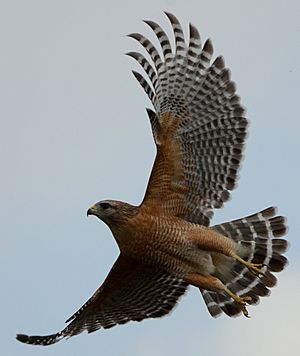
Male red-shouldered hawks are about 38 to 58 centimeters (15 to 23 inches) long. They usually weigh around 550 grams (1.2 pounds). Females are a bit bigger, measuring 47 to 61 centimeters (18 to 24 inches) long. They weigh about 700 grams (1.5 pounds). Their wings can spread from 90 to 127 centimeters (35 to 50 inches) wide.
Adult hawks have brownish heads and reddish chests. Their bellies are pale with reddish stripes. Their tails are quite long for a Buteo hawk and have thin white stripes. You can see red "shoulders" on these birds when they are sitting still. Their upper bodies are dark with light spots. They also have long yellow legs. Hawks living in western areas might look more red. Those in Florida are usually paler.
Young red-shouldered hawks can sometimes be confused with young broad-winged hawks. But you can tell them apart by their long tails and crescent-shaped markings on their wings. They also fly differently, with more flapping, like a Accipiter hawk. The red-shouldered hawk is usually larger than the broad-winged hawk. It is also a bit smaller and thinner than most other common Buteo hawks in North America.
Sometimes, people confuse this bird with the common red-tailed hawk. However, red-tailed hawks are larger and heavier. They have wider wings that are more even in size. They are also paler underneath, and often have a reddish tail. Red-tailed hawks also tend to soar smoothly with their wings held in a slight "V" shape.
How Scientists Classify Red-shouldered Hawks
The red-shouldered hawk belongs to the Buteo genus. This group includes medium-sized birds of prey with strong bodies and wide wings. In Europe, birds in this group are called buzzards. But in North America, they are known as hawks.
There are five different types, or subspecies, of Buteo lineatus. They live in different areas and have slightly different colors:
- B. l. lineatus (Gmelin, 1788)
- B. l. alleni - Ridgway, 1885
- B. l. elegans - Cassin, 1855
- B. l. extimus - Bangs, 1920
- B. l. texanus - Bishop, 1912
Where Red-shouldered Hawks Live and Their Homes
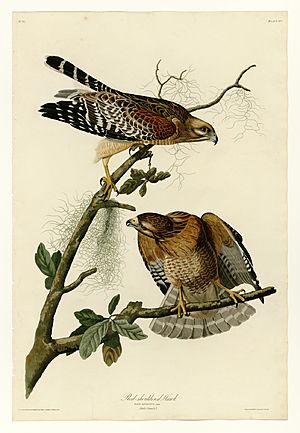
An eastern group of these hawks lives across southern Canada, from New Brunswick to Ontario. They also live south through the eastern U.S. Great Plains, down to Florida, the Gulf Coast, and eastern Mexico. Only the hawks from the far northern areas move south for winter.
A western group lives west of the Sierra Nevada mountains. This area stretches from northern California to northern Baja California. Recently, they have also started living in Oregon and Arizona.
In winter, eastern hawks go south to places like southern Wisconsin, Oklahoma, and Florida. Sometimes, they go as far south as Jalisco and Veracruz, Mexico. Western hawks usually do not migrate. These birds avoid high mountains during winter.
Red-shouldered hawks are forest birds. In the east, they live in wet hardwood forests, flooded swamps, and mixed forests with both leafy and pine trees. They like areas where the lower branches of trees are not too thick. This makes it easier for them to hunt. You can even find them in some suburban areas where houses are mixed with woodlands. In the west, they live in forests near rivers and in oak woodlands. They also live in eucalyptus tree groves and some neighborhoods.
Red-shouldered hawks usually migrate short to medium distances. Most travel between 300 and 1,500 kilometers (186 to 932 miles) each way. They often follow natural pathways like ridges and coastlines. More red-shouldered hawks are seen at coastal spots than inland during migration. Young hawks often fly south before the adults in autumn. In spring, adults fly north before the young. These hawks usually travel alone. However, sometimes they form small groups of three or more birds. They generally avoid flying over large bodies of water.
Red-shouldered Hawk Behavior
Diet
Red-shouldered hawks look for food while sitting on a treetop or flying over forests. When they spot prey, they drop straight down from the air to catch it. They might hide food near their nest to eat later. If they are in open areas, they sometimes fly low to surprise their prey.
Like most birds of prey, red-shouldered hawks have very sharp eyesight and good hearing. Their talons (claws) are strong enough to kill animals as big as themselves. Small mammals are usually their main food, especially rodents. They often eat voles, gophers, mice, moles, and chipmunks. They also sometimes hunt slightly larger mammals like rabbits and tree squirrels.
Other foods they eat include amphibians, reptiles (especially small snakes), birds, fish, and large insects. They can attack birds as large as a ruffed grouse or a ring-necked pheasant. During winters, red-shouldered hawks sometimes learn to hunt birds that visit bird feeders. In some places, crayfish are an important food source for them. They have even been seen eating unusual things like eastern screech owls, flying squirrels, and deer that have been hit by cars.
Reproduction and Life Cycle
Red-shouldered hawks build their nests in deciduous (trees that lose their leaves) and mixed wooded areas. These spots are often close to water. They have been known to nest near homes and open water, but this is less common. They choose nesting sites with many different types of trees.
Like almost all birds of prey, red-shouldered hawks stay with one partner and defend their territory. When they are trying to attract a mate or protect their area, you can hear their loud, screaming kee-aah call. They usually repeat this call three to four times. During courtship, they fly together in wide circles while calling. They might also soar high and then dive towards each other. Males may also do a "sky-dance." This involves flying very high, then making a series of steep dives, followed by wide spirals and quick climbs. These courtship flights usually happen in the late morning and early afternoon.
The mating season for red-shouldered hawks is from April to July. It is usually busiest between April and mid-June. The male and female build a nest made of sticks. They sometimes add shredded bark, leaves, and green twigs. They often use the same nest every year, fixing it up with new sticks in the spring.
A female hawk usually lays three to four eggs. The eggs are blotchy and can be brown to lavender in color. They are about 54.5 by 43 millimeters (2.1 by 1.7 inches) in size. The eggs hatch after 28 to 33 days. The chicks do not all hatch at the same time. The first chick might hatch up to a week before the last one.
Newborn chicks weigh about 35 grams (1.2 ounces). The female hawk almost always stays with them for up to 40 days to keep them warm. Pairs that nest earlier in the season tend to lay more eggs and have more chicks survive. The male usually brings food, but he will also sit on the eggs and care for the chicks sometimes. The young hawks leave the nest when they are about six weeks old. But they still rely on their parents for food until they are 17 to 19 weeks old. They might stay near the nest until the next breeding season. These hawks can start having their own families when they are 1 or 2 years old.
Red-shouldered hawks can live for almost 20 years. However, most do not live half that long. Only about half of them survive their first year. Each year, the overall success of nests can be lower than 30 percent. Young hawks can die early due to bad weather or, more often, from not getting enough food. Young hawks can also get sick from parasites.
Humans can also harm red-shouldered hawks, sometimes by accident. This includes hunting, hitting power lines, car accidents, and logging (cutting down trees). Other animals also hunt red-shouldered hawks. Raccoons, martens, fishers, and large tree snakes can eat eggs, chicks, and sometimes even adult hawks sitting on the nest. Adult hawks are strong predators themselves, so they have fewer natural enemies. But they can be hunted by great horned owls, red-tailed hawks, barred owls, other red-shouldered hawks, northern goshawks, peregrine falcons, prairie falcons, and bald and golden eagles. In western New York, great horned owls are a main reason why nests fail.
Sometimes, red-shouldered hawks have mated with other types of hawks, like the Gray Hawk (Buteo plagiatus), Red-tailed Hawk (Buteo jamaicensis), and Common Black Hawk (Buteogallus anthracinus).
Conservation Status of the Red-shouldered Hawk
Before the 1900s, the red-shouldered hawk was one of the most common birds of prey in North America. But their numbers dropped a lot because mature forests, especially the wet hardwood forests they like, were cut down. Changes in their homes also led to more red-tailed hawks, which sometimes hunt red-shouldered hawks.
Also, in the early 1900s, it became easier to get guns. This led to a lot of hunting of all birds of prey, including red-shouldered hawks. This continued until conservation laws were put in place later in the 20th century.
Now, forests are growing back in some areas, and hunting birds of prey is banned. This has helped red-shouldered hawk populations become more stable. The species is not currently considered in danger. In Florida, the red-shouldered hawk is probably the most common hawk you can see and hear.
However, human activities still threaten these birds. These include logging, poisoning from bug sprays, and pollution from factories. Before a pesticide called DDT was banned in the United States, it harmed red-shouldered hawks and other birds of prey. DDT made their eggshells thin and easy to break, which meant fewer chicks could hatch. Accidents with power lines and cars also hurt hawks. But even with these dangers, losing their forest homes is still the biggest threat to red-shouldered hawks.
Red-shouldered Hawks in Art
The famous artist John James Audubon drew the red-shouldered hawk in his book called Ornithological Biographies.
Gallery
See also
 In Spanish: Busardo hombrorrojo para niños
In Spanish: Busardo hombrorrojo para niños





